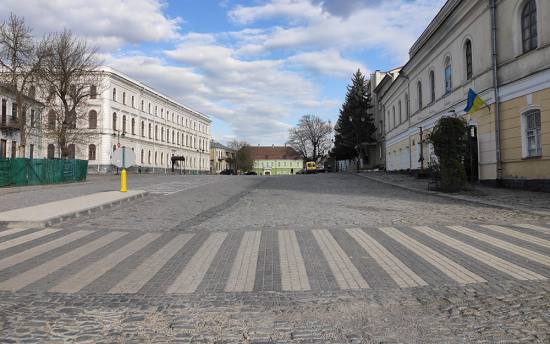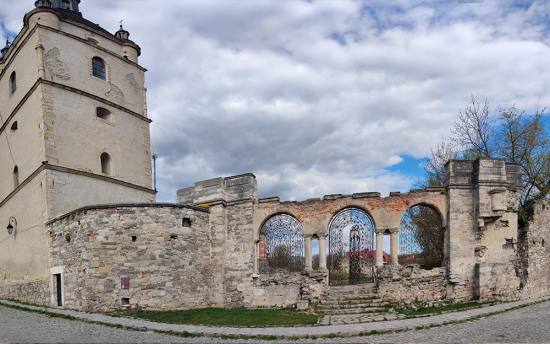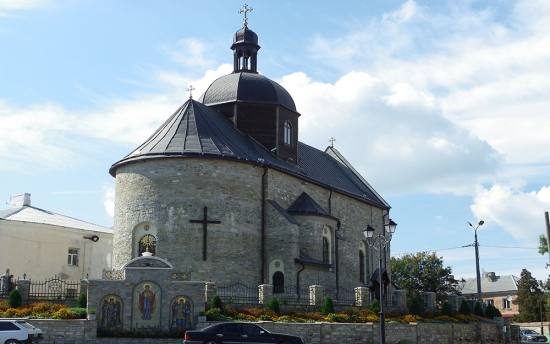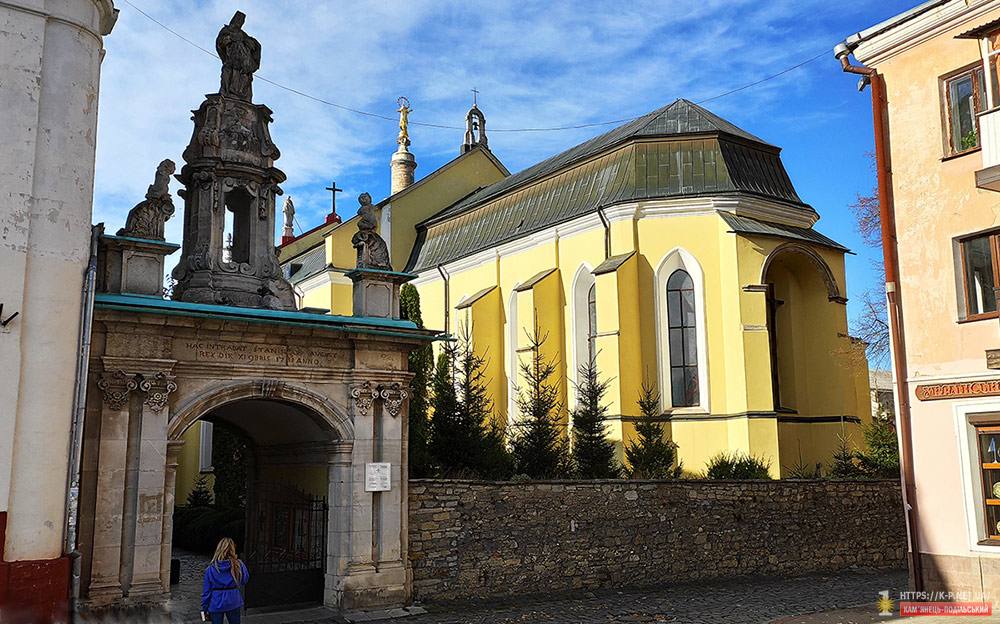The birth date of Kamyanets-Podilsky is very debatable. There are several theories about its foundation. The newest theory tells us that Kamyanets appeared in the beginning of the 1st century A. D. In that time the city was located in the land of Dacia. It was called Klepidava or Petrydava. In the beginning of the 100’s A. D. the Roman emperor Trayan captured Petrydava. The city became a Roman colony. This theory is based on the works of Roman historian Ptolemy, but it’s still very questionable.
---
?♂️ Book a guided tour in Kamianets-Podilsky
---
According to the next theory, which is based on archaeological research, Kamyanets-Podilsky existed in time of Kievan Rus'. In that period the area was called Ponyzzya (Lowlands).
In the 1200’s, Tatars captured territories of Kievan Rus' and made princes pay taxes. In 1362 Lithuanian Prince Olgerd defeated the Tatars in the battle on Blue Waters River. He drove away the Tatars from Ponyzzya and gave this area to his nephews as a present – the four brothers Princes Koryatovich.
The third theory about the city’s foundation is connected with the Koryatovich brothers. It is based on the Jury Koryatovich Charter, which proclaimed The Magdeburg Right for Kamyanets-Podilsky in 1374. This is the first written mention about the city. From that time the area was called Podolia (another synonym of Lowlands).
From 1362 until 1430 the city was ruled by Lithuanian Princes. In the end of the 1300’s, The Great Lithuanian Principality became weak. It couldn’t match the power of the Polish kingdom. In 1430 Kamyanets-Podilsky was given to Polish King Wladyslaw Jagiello.
In the period of Polish rule, which lasted about 300 years, Kamyanets-Podilsky developed into a strong trading center reinforced with powerful defensive constructions. Many catholic churches, including St. Peter’s and Paul’s Cathedral, were built during this time.
In 1672, Kamyanets-Podilsky was captured by Turkish Sultan Mohammed IV. For 27 years Kamyanets-Podilsky was ruled by Turks. In 1799 they made a peace deal with the Polish Kingdom and abandoned the city. Poles came back to Kamyanets-Podilsky after this agreement.
In 1793, after The Second Split of the Polish kingdom, Podolia with Kamyanets-Podilsky became the property of the Russian Empire.
In 1917, monarchy power in Russia failed after a revolution. Some Ukrainian patriots wanted to create an independent Ukrainian state. They created a temporary authority called the Ukrainian Central Council with Mychailo Hrushevski in charge. He was a politician and historian. Members of the Ukrainian Central Council had very different political views. So, UCC was not strong and fell apart. In 1918, Pavlo Skoropadsky was the leader of the Ukrainian patriots. He became a head of state. People called him “hetman”. But Pavlo Skoropadsky couldn’t defend the country’s independence from the army of Soviet Russia. After losing of several battles, he refused to be head of state and left Ukraine. Ukrainian socialists created another temporary authority, which was called the Ukrainian Directory with the head – Simon Petlura. He also was commander-in chief of the Ukrainian army. But he couldn’t defend the country against huge Soviet forces. In 1919 Kamyanets-Podilsky was the capital of Ukrainian National Republic for a few months. In 1920, all the members of the Ukrainian Directory were arrested. The territory of Ukraine was occupied by Soviet troops. Ukraine became a Soviet republic.
During the Second World War, Kamyanets was captured by Nazis. It was liberated in 1944. Now the Old City of Kamyanets-Podilsky is National Historical and Architectural Preserve. This is one of the seven wonders of Ukraine.
St. Peter’s and Paul’s Cathedral
 It was built by Dominican friars in the 14th century. Now it is the center of the Kamyanets-Podilsky catholic diocese.
It was built by Dominican friars in the 14th century. Now it is the center of the Kamyanets-Podilsky catholic diocese.
The main entrance into the cathedral area is the Triumphal Arch. It was built in honor of Polish King Stanislaw Augustus, who visited our city in 1781. The architect’s name is Yan de Vitte. He created the Triumphal Arch in a later Baroque style. There is a Latin inscription, which states that Stanislaw Augustus passed through this arch in 1781. On the top of the arch there is a statue of St. John of Nepomuk.
On the way from the Triumphal Arch to the courtyard opposite the cathedral, there is the statue of Christ in Sorrow. After capturing the city, Turks robbed the graves in the cathedral cemetery. That was a huge tragedy for all the Christians in the city. So after the Turkish troops abandoned Kamyanets, the Christians decided to put a statue of Christ in Sorrow here. It was erected in 1756. On the bottom of the statue, on the pedestal, there is a Polish inscription “Kaminiec Pamieta” which means “Kamyanets Remembers”.
On the courtyard opposite the cathedral there is a statue of John Paul II. This statue was erected here in 2007 after the Pope’s death. It is made of bronze. On the bottom of the statue there is a Latin inscription – “Totus Tuus”. It means “Forever Yours”. That was John Paul’s principle, a man who dedicated his life to other people.
To the left of the Pope’s statue, there is the Gate of St. Yatsek with a Latin inscription that means “Respect Forefathers’ Traditions”.
On the southern part of the courtyard there is the monument that looks like a stone oak with cut branches. This is the monument in honor of Michal Jerzy Volodyevsky, who protected the city during Turkish besiege and assault.
Near the cathedral there’s a high stone tower. It’s the Muslim minaret. In the city’s Turkish rule the Turks turned this cathedral into a Muslim mosque with a minaret. Its height is 36 m with 142 steps inside. This is the only minaret in the world which has a Virgin Maria statue on its top.
The Cathedral consists of a nave, two transepts, presbytery and a few chapels. In the Southern chapel to the right from the nave there is a statue of Our Lady of Lourdes. In that chapel there is also a tombstone of Laura Pshezdecka. It was made from white Italian marble in 1876. The sculptor was Victor Brodsky, a member of the St. Petersburg Art Academy. Laura was the daughter of rich Count Pshezdecki. She died when she was 21 years old. This sculpture is very detailed and symbolic. Near the Laura’s bed, a little Cupid is standing. He is holding a torch which is dropped down low. Also there’s a marble book, opened to the 21st chapter corresponding to Laura’s age when she died. She died in 1874. This monument was kept in the crypt of the Pshezdecki family. In 1938, this monument was brought to St. Peter’s and Paul’s cathedral when there was a museum.
In the nave there is an altar with Jesus Christ on the Cross, God, the Holy Ghost, archangels, and archbishops. The presbytery is separated from the nave with the wooden altar rail made in Romanesque style. Also in the nave there is an organ on the balcony. It was made in the 1800’s by an Austrian company called “Karl Hesse”. It has 972 pipes and two manual keypads.
In the left transept there are two pots with the preserved hearts of bishops – Nicholas Dembowski and Francis Mackiewicz.
The Polish Market Square
 The Polish market is the name of central square of the Old City. In the medieval period, there were three large ethnic communities in the city: Russ (Ukrainian), Armenian, and Polish. Each of them had its own magistrate according to the Magdeburg Right. Each community was living in a different district. The city center belonged to the Poles. On this square people were selling different goods.
The Polish market is the name of central square of the Old City. In the medieval period, there were three large ethnic communities in the city: Russ (Ukrainian), Armenian, and Polish. Each of them had its own magistrate according to the Magdeburg Right. Each community was living in a different district. The city center belonged to the Poles. On this square people were selling different goods.
In the middle of the Polish market there is a creamy colored building with a Clock tower. This is the City Hall, which is one of the oldest City Halls in Ukraine. It dates back to the 15th century. The Polish magistrate was located here. The tower has two clocks. The upper one is new and it strikes every hour. The lower one now is broken. It’s used as a decoration. On the top of this building there is a symbol. It’s a white sun with 16 rays. This is the emblem of Podolia land. It symbolizes productivity and peace. Near the City Hall there is a pink building with 8 sides. This is the Armenian Well house. The well was made and paid for by a rich Armenian merchant named Narses. Its depth is about 55 m. When people had dug this well, they understood that the water in here couldn’t be used for drinking, because the water was bitter and had a lot of salt.
Dominican Church of St. Nicolas
 It is located on the shortest street of the city, which is called Dominican street. It connects two big squares: Polish market and Armenian market. The friars of the Dominican order were the first among all other ecclesiastical orders in Kamyanets-Podilsky. They appeared in the city in the late 1300’s. The Dominican friars built two catholic churches: St. Peter’s and Paul’s Cathedral and St. Nicolas church.
It is located on the shortest street of the city, which is called Dominican street. It connects two big squares: Polish market and Armenian market. The friars of the Dominican order were the first among all other ecclesiastical orders in Kamyanets-Podilsky. They appeared in the city in the late 1300’s. The Dominican friars built two catholic churches: St. Peter’s and Paul’s Cathedral and St. Nicolas church.
The history of St. Nicolas church is closely connected with the family of the rich Count Potocki. There was a legend in their family that Potocki would prosper as long as Dominican order exists. And all Potocki descendants believed in this legend and always helped the Dominicans. Above the main entrance to St. Nicolas church there is a stone slab. It was made in honor of Michal Franciszek Potocki and his restoration of the church in 1755. Above the slab there’s a bas-relief image of a dog with a torch in its mouth. It’s the symbol of the Dominican friars. There is a play on words here. In Latin, dog is “canis” and the Dominicans are “dominicani”. So, the literal translation is “dogs of God”. The torch in the mouth symbolizes God’s light.
Above this image, there is the coat of arms of the Potocki family. It’s a cross with 7 endings in a flowers frame. Also over this coat of arms there are three statues. The upper one is Virgin Maria; the two others are St. Dominic on the left and St. Jacek on the right.
The two-story stone house adjoins the Belfry of St. Nicolas church on its left. This is the Potocki house of the 18th century.
Armenian Market Square
 In the southern part of the city there is the Armenian district. It begins from the square, which is called the Armenian market. On this square near Dominican street, a huge three-story building is located. It was built in the beginning of the 1800’s as a theatre. Later it was rebuilt into a court house. In 1919, this building functioned as the Military Ministry of Ukrainian National Republic’s headquarters was working. To the left, almost on the corner of this building, there’s a memory slab of Simon Petlura. He was the commander-in-chief of the Ukrainian army and the head of the Ukrainian Directory. Now this building is a textile factory, which makes men’s suits for Italian companies. The administrative building of the textile factory is located on the opposite side.
In the southern part of the city there is the Armenian district. It begins from the square, which is called the Armenian market. On this square near Dominican street, a huge three-story building is located. It was built in the beginning of the 1800’s as a theatre. Later it was rebuilt into a court house. In 1919, this building functioned as the Military Ministry of Ukrainian National Republic’s headquarters was working. To the left, almost on the corner of this building, there’s a memory slab of Simon Petlura. He was the commander-in-chief of the Ukrainian army and the head of the Ukrainian Directory. Now this building is a textile factory, which makes men’s suits for Italian companies. The administrative building of the textile factory is located on the opposite side.
On the Eastern side of the Armenian market there are two houses. The left one has a gutter, which was made in the form of a Dragon. This house is an ex-Rus’ magistrate building. Now it’s the “Kamyanets” National Historical and Architectural Preserve’s administrative building. To the right of it there’s a two-story house, which was built as a Theological Seminary. Now it’s the Picture Gallery.
On the corner of the Armenian square, to the right of the Picture Gallery, there’s a yellow two-story building with the shingle roof. It was the house of the Armenian bishop. Nowadays it’s the Archaeological department of Kamyanets-Podilsky State Historical Museum Preserve.
On the Southern side of the Armenian market to the right of the Archaeological department there’s a grey building covered with plaster. It’s the city’s Fire Station.
Armenian Belfry and St. Nicolas Church
 Between the Fire Station and the Archeological department there is a street. This street is called “Armenian”. Down this street, there’s the Bell Tower of the Armenian Church. The bell tower has gun-slots and four semi-towers on its top. This belfry could be used as a military tower. The Armenian Church of St. Nicolas was built in the end of the 15th century. In the 1930’s this church was destroyed due to soviet atheistic politics.
Between the Fire Station and the Archeological department there is a street. This street is called “Armenian”. Down this street, there’s the Bell Tower of the Armenian Church. The bell tower has gun-slots and four semi-towers on its top. This belfry could be used as a military tower. The Armenian Church of St. Nicolas was built in the end of the 15th century. In the 1930’s this church was destroyed due to soviet atheistic politics.
Further down Armenian street and then to the lane on the left, there’s another Armenian church. It was also named in honor of St. Nicolas. This is the oldest ecclesiastical building in Kamyanets-Podilsky. This church dates back to the late 14th century.
Holy Trinity Church
 On the way to the Fortress on left side of Zamkova Street, there is another catholic church. Its name is Holy Trinity Church. It was built by the Trinitarian friars in the beginning of the 1700’s. The main purpose of the Trinitarians was to ransom imprisoned Christians from the Turks.
On the way to the Fortress on left side of Zamkova Street, there is another catholic church. Its name is Holy Trinity Church. It was built by the Trinitarian friars in the beginning of the 1700’s. The main purpose of the Trinitarians was to ransom imprisoned Christians from the Turks.
On the top of the church there is a Christ statue. On both sides of him there are busts of Christian prisoners in shackles. Below the Christ statue there’s an image of a triangle. This is the all-seeing eye of God. Near the gate there are three statues. The closest to us is Virgin Maria. Two statues behind her are the founders of the Trinitarian order. Nowadays this is the Greek-Catholic church of St. Josaphat.
The viewpoint opposite the Fortress
 To the South in the bottom of the canyon, there is a huge grey stone building. That is the Fortress’ Barracks. They were built in the 1870’s for the city garrison.
To the South in the bottom of the canyon, there is a huge grey stone building. That is the Fortress’ Barracks. They were built in the 1870’s for the city garrison.
Also in the canyon, on the left bank of the Smotrych River, there’s a defensive construction. This is the Rus’ Gate. It protected the Southern entry way to the city.
On the Western side of the canyon, in the bottom, there’s an all-wooden church. Its name is “Ascension of Christ”. It was built in 1799.
The Old City is located on a peninsula and surrounded by the Smotrych River. The river lies in a canyon of high rocks. The Fortress was built on the isthmus of the peninsula. And due to its location the Fortress was invulnerable to invaders. The Fortress is connected with the Old City by a bridge, which was built in the 16th century.
The Old Fortress
 The Fortress was built in the 14th century by Lithuanian Princes Koriatovych. Some centuries later during Polish rule in the city, the Fortress was reinforced. In the end of the 1700’s Kamyanets-Podilsky was annexed to the Russian Empire. From the beginning of the 19th century, the Fortress had lost its military functions and was being used as a prison. After 1928, the Fortress has been a museum.
The Fortress was built in the 14th century by Lithuanian Princes Koriatovych. Some centuries later during Polish rule in the city, the Fortress was reinforced. In the end of the 1700’s Kamyanets-Podilsky was annexed to the Russian Empire. From the beginning of the 19th century, the Fortress had lost its military functions and was being used as a prison. After 1928, the Fortress has been a museum.
After entering the Fortress to the right of the entrance there’s a tower, which is called “New Eastern Tower”. Under this tower, a well was dug. Its depth is about 40 m.
To the left of the entrance there is 6-story tower. Its name is Papal Tower (Julian’s Tower, and later Karmalyuk Tower). In 1513, Pope Leo X donated funds towards the reinforcement of the Fortress, which were used for the reconstruction of the several towers to be named after the Pope. The Papal insignia has been preserved on them.
From 1818 to 1823, Ustimov Karmalyuk was imprisoned in this tower. He was the chief of the peoples’ rebellion. By the end of the 15th to early 16th centuries, the principal fortress wall ring had been formed with the following towers: Papal, Kovpak, Tenczinski, Liaska, Daytime, Small West, Rozhanka, and Lanckoronski.
In the canyon, outside the Fortress wall ring, “Water (Smotrych) Tower” stood. It had a well, which was connected with the Fortress by a special system providing its water-supply.
In the dungeon of Rozhanka Tower there is an exhibition of waxfigures, which represent warriors that took part in the Turkish assault of 1672.
In the 16th and early 17th centuries the medieval defense system reached its pinnacle of glory. The advent of long-range artillery called for yet further reinforcement of the western side of the Fortress – the most vulnerable section. Teofil Shomberg, military artillery engineer, put together a project called “New Castle”, the realization of which began in 1617 and was completed in 1621, on the eve of the Khotyn War. It was a bastion defense.


